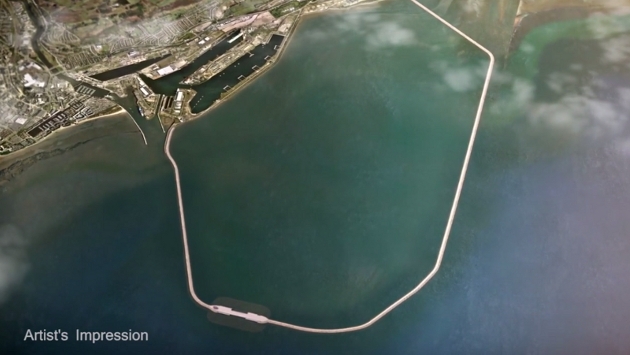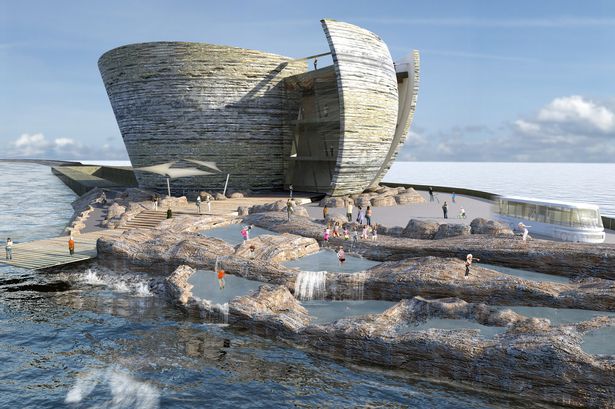The UK is set to have the first ever man-made lagoon power plants (pictured). Four of the six structures are to be based in Wales, and one each in Cumbria and Somerset.
Planning work for a £1bn Swansea lagoon has already begun and has been backed by Ed Davey, the UK energy secretary. The walled-in lagoon would extend five miles out from the coast and would be two miles wide (pictured below).

We have the best tidal resource in Europe and now have a sustainable way to make the most of this natural advantage– Mark Shorrock, Tidal Lagoon Power’s chief executive
The six lagoons would cost a total of £8bn and would eventually be able to generate 8% of all UK electricity. Projects would be funded by electricity bill payers.Â
The lagoons will be based in areas with the greatest difference between high and low tide. As the tide comes in, water is built up outside the gates of the lagoon and rushes through the turbines to create electricity. As the tide goes out, the gates are opened to generate power as the water returns to the sea.Â
Tidal Lagoon Power, the company planning the developments, also wants to build a 90-turbine lagoon in the Severn Estuary between England and Wales. The company says it would have a capacity of between 1,800 and 2,800MW, enough to power every home in Wales, but there is opposition to the plan.
Mark Shorrock, Tidal Lagoon Power’s chief executive, said: “We have the best tidal resource in Europe and the second best worldwide. We now have a sustainable way to make the most of this natural advantage.Â
“There is still a long way to go and many environmental surveys to undertake but we will work in partnership with all nature conservation bodies so as to understand, avoid, minimise and mitigate any environmental impacts.”

The deadline for planning permission for the projects is 2017. If approved, they should be working by 2022.
Most large turbine components and generators are to be made in Britain and assembled in Wales.Â
Read more about how the lagoon works here.
Britain’s first surf lagoon is set to open in Wales later this year.Â
Photographs courtesy of Tidal Lagoon Power
Comments
Comments are closed.







So the works are to be paid for by the consumer – so when they are complete who will own them. Not the utility companies I trust?
I always thought that it is the shareholders of a company that finance capital expenditure but it seems not to be the case. I suspect our replacement gas infrastructure is similarly being paid for by the consumer. No wonder our energy costs so much. So if we are to pay the capital cost then I expect to see energy costs drop massively once the works are completed. I’ve made a diary note for 2022!
But why stop with lagoons? The tide off the North foreland – between Margate and Broadstairs – runs at 8 knots on both the ebb and flow, Surely a series of submersed turbines would merrily generate power for 22 out of the 24 hours of the day without the need for constructing a “lagoon”
One of the fun things about the modelling of tidal flows in the areas around proposed developments such as this…. is the probability that the effects of the tidal lagoon will be experienced in all sorts of unexpected ways. Unexpected, that is, by those proposing the scheme, but entirely predictable nonethless. The most obvious probable casualty of the Swansea Bay scheme will be the miles of glorious sand stretching from West Cross to the Neath estuary.
Deposits in the inter-tidal zone are critically dependent upon the circulation of the tides; where the tides are hurried by rock promontaries, the only deposits are those with feet and suckers to cling onto the rocks. Where the water is sluggish, we get lots of nice mud. Swansea Bay falls between these two extremes, with just enough current to drop golden sand in a fine veneer.
Stick a tidal lagoon in the middle and you can bet a small fortune that the sand will disappear – either by scour from increased water speeds, or to be replaced by mud as the bay circulation slows to next to nothing.
Extracting energy from nature is fine, but if you do it on a small scale and get it wrong, the mess left costs very little to sort out. The risk with this kind of megalomania, is that its being done by people who only have £ signs in their eyes, and will make sure if – probably when – it goes belly up, they will be far away from any sort of justice. On a private island in the Carribean. Likewise their bank account.
Value what you have before trashing it for something you can probably do without.
For 50 years I’ve been saying they should do this in Morecambe Bay!